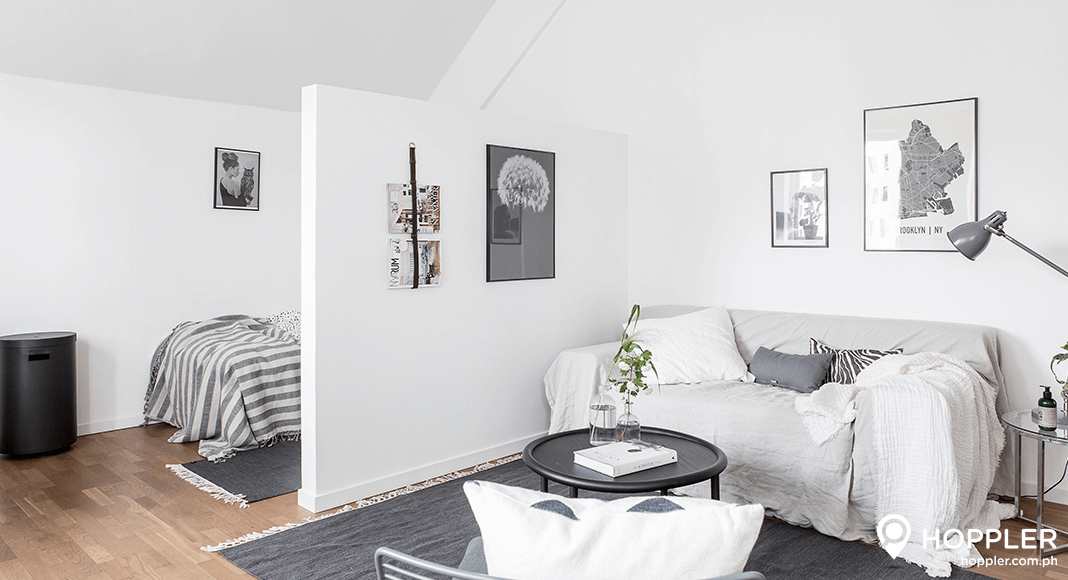Regain Your Living Space: Interior Design and Organization Tips For Your Home

We list down great tips on how to create new spaces like a home office, homeroom, or an extra bedroom without needing to increase square footage.
If you are living in a home with limited space, it can get really cramped, especially now that every member of the household is now forced to shift their daily life at home. Some parents now work at home or on a flexible schedule, meaning they work some days at the office while practicing social distancing and some days at home. Students, even kids, have spent one entire school year studying via online classes. Some were inspired to pursue new career paths or open a new business online and operate their business at home.
Add that with everyday and recreational activities, your condo, townhouse, or house and lot requires an interior design overhaul to address this now-popular question: is there a way to eke out extra square footage to accommodate all our family’s living space needs without needing to drastically extend the home or move into a bigger home? Do I add new space over or under? And for homes that are impossible to extend square footage (like a condo unit, for example), is there a way to create new living spaces in order to live comfortably?
Whether you own a condo, townhouse, apartment, or house and lot, we will take you every step of the way and help you to regain extra living space.
Entryway
Your entryway is the most used space in the house, and your first defense from these uncertain times.
With COVID-19, we now see our entryway not only as the first area of your home where you welcome guests and see family off safely, it is also now your first line of defense. It pays to be safe, so it is important that you set up your entryway as a functional space and have an area where people can come and go quickly, efficiently, and safely.
- Create a small nook where you can place your home slippers, frequently-used bags, footwear, coats, and even your sanitizing station. Your nook can be a bench plus wall-mounted hooks or a slim, open closet with a stool.
- Make sure that your nook also has a laundry bag or bin where you can deposit used hats, coats, socks, and even shoes and bags (ex. Tote bags). Empty them immediately to be disinfected and washed.
- Your sanitizing station should include the essentials, including face masks, face shields, alcohol, disinfecting spray, paper and wet tissue.
- Store a collapsible storage box in your nook to place delivery boxes. This way, you can put them all in one place to sanitize and then sort out later.
- Don’t forget the space at the back of your door. You can place a full-size mirror, wall-mount hooks for hats, and even an umbrella holder.
- In Japan, each home has an entryway/receiving area called genkan. You can fake a genkan by placing a large mat or carpet you can sanitize.
- Never store your valuables in the entryway. Instead, invest in a bag organizer so you can simply take your bag contents out and put the used bag in the laundry basket or bin.
Living Room
Small furniture, muted colors, some greens, and smart storage solutions can help make your living room a multifunctional living space without the clutter.
Your living room and family room get the messiest, even without you trying. This is because this room gets the most traffic from everyone in the family! Maximize space with multifunctional furniture , well-placed furnishings, and some plants to brighten up the space!
- Consider using furniture that has multiple purposes. A sofa bed is great for additional sleeping options. Ottomans with storage are great to help keep your knick knacks like photo albums, video game stuff, and more. A foldable table can work as a TV table, service table, or as an office table when the kitchen table or the study room/office is occupied.
- Mount your TV. You can also install an open shelf that can act as your entertainment center below the TV for a more modern, less cluttered look.
- Keep it neutral. The family room is already the busiest room in the house, so make sure you keep stuff that is not meaningful or functional for you away from this room. Keep the wall colors neutral or in light or pastel shades.
- A strategically placed mirror can also help brighten the space up. The illusion helps expand the size of your room as well.
- Build strategic storage like a slim bookshelf. If you have a smaller family room, opt for floating shelves or built-in bookcases so it would not take up floor space.
- Pick a large area rug and place it under the couch, coffee table, and other furniture. The rug helps draw the eye wider, and also give an illusion of bigger space.
- Add purposeful elements. Soft throw pillows can double as floor seats or pillows. Place a couple or more plants to liven up the space.
Dining Room/Kitchen
The kitchen is the busiest room of your entire home. For it must be functional, welcoming, and an easy place to cook meals or make snacks. In homes with limited square footage, they double up as dining rooms, and belong in an open-plan configuration together with the living/family room. As such, this room needs to be tidy and uncluttered.
- Pick the right color scheme, especially if your home follows an open plan. Similar to your living room, use lighter, bright colors to make your kitchen instantly seem larger. If you want a pop of color, you can introduce them via your countertops.
- Declutter your countertops and dining table. Use your countertops strictly as a workspace when cooking or baking.
- Use wall hooks or magnetic strips to hang your stainless steel utensils, chopping board, and spice jars.
- For easy access, put your most-used appliances in a separate shelf. This way, you don’t need to take them out of the cupboards or drawers.
- If you have an open wall, free to use them by installing a pegboard or racks with hooks to store everything else like coffee mugs, pots, pans, and other lighter appliances.
- Run a noiseless curtain strip across your kitchen and hang a solid block color cloth from ceiling to bottom. This way, you can open your kitchen/dining room as another multipurpose room.
- Fragrance can also do wonders. Install an air purifier and a fragrant diffuser to disguise kitchen smells.
- Invest in mood lighting. You can invest in a lamp or install an LED light strip to highlight certain areas in the living room.
Bathroom
Your bathroom should be both an oasis and a storage haven.
The room you wake up first to in the morning and see late at night often has the worst storage and interior decor. Help transform your bathroom with custom-build storage solutions, mood lighting, and fragrance.
- Make sure that your storage doesn’t go all the way to the floor to give an illusion of bigger space. Install some floating shelves only when you need it.
- Mirrors reflect light, so placing one in the bathroom is both functional and essential, especially for smaller bathrooms. You may also consider a medicine cabinet with a mirrored front, and install LED lights on the side to brighten up your space.
- Install a glass divider instead of the traditional shower curtain. The glass divider does not visually divide the space, but does the job of keeping water away from the rest of the bathroom.
Bedroom
A bedroom may be a place for sleeping, but it can be a multifunctional room if you want to.
When we talk about the bedroom, we talk about a living space that is not just a place to catch a good night’s sleep. It is also a personal, sacred space where you can find solace.
- Invest or convert your bed into a multifunctional furniture. You can go for a loft bed, with the bottom part serving as your study or living room area, or a full-size bed with storage underneath. You can even consider installing a Murphy bed for kids, so they have more play space in the room.
- Mount a mini-shelf if you do not have any space for nightstands. You can use a floating shelf or attach a short wooden block beside your bed frame.
- Mood lighting can help set the mood. You can invest in some lamps, wall lights, or fake it using LED lighting strips installed at the back of the bed frame.
- 18. Pick Light Window Treatments
- If your bedroom has a window, open it up. If the space allows it, place the bed away from the window and place your reading nook or study area near the window. Installing zebra blinds will also help you black out and welcome sunlight with ease.
- Create zones for playing, sleeping, and quiet time or studying. Utilize the walls by installing a chalkboard or whiteboard sticker for them to draw. Install low shelves so kids can put back toys, books, and other items they should be putting away after playtime.
- Konmari your clothes. Store out-of-season clothing, put clothes that you frequently use, and give away to charity those that no longer bring joy (ex. clothes that no longer fit you).
Dual-Purpose Rooms
Just because a room is designed a certain way in a layout you are given, it does not mean that you are confined to using that space in that particular form.
- If you have a slightly larger bathroom, you can dedicate the farthest corner from the entrance as your laundry area. Invest in an automatic washing and dryer machine so you can do everything in just one appliance.
- If you have a custom-built closet inside your bedroom, how about you do this instead: dedicate one section for your clothes and another one as your instant office space? This way, you have the option to “close” your office and get quickly into a relaxing mode after office hours in the bedroom.
- A home office and homeroom (homeschool room) in one multipurpose room allows you to dedicate that living space as the “serious” space for everyone at home. This way, both adults and kids can simply focus on doing their work or school stuff in that room, and be able to mentally relax once they leave that room. Make the room more effective by setting up individual workstations, a supply cabinet, and desktop computers for virtual sessions/meetings/online classes. Dedicate a wall above the workstations to put anything of importance: floating shelves for books and supplies, whiteboard for important notes, and a family schedule.
No matter the actual size of your house and lot, condo, townhouse, or apartment, it requires the right mindset to redesign your living space to your needs using these tops. The key is recognizing what you truly need not just to survive, but also thrive in these uncertain times.
Stay tuned to this space for more interior design tips and inspiration by Hoppler!




